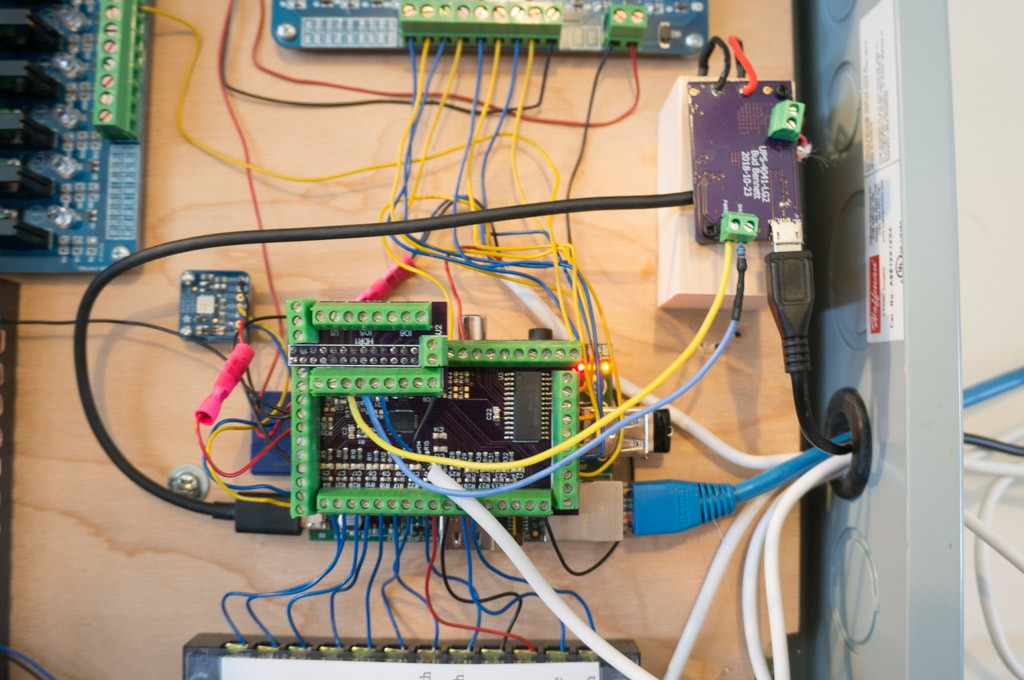
I installed the modified UPS board, and 100F supercap, into my heating system. It did not go well. The UPS would power the Pi and peripherals the first time that it was plugged in, but it would not apply power after a disconnection. I found two major issues that had to be fixed.
Oscillation
After unpacking the oscilloscope and looking at a few waveforms, I determined that the LTC4041 was put into an oscillation caused by its power fail comparator and the input switch. When the AC adapter is first powered up its output voltage ramps toward the final steady state voltage and it is forcing full current into the output. When the input voltage of the UPS reaches 4.75V the power fail comparator allows the input switch to connect the input to the output and there is a surge current which tends to glitch the input voltage downward. Since the AC adapter is still driving the input voltage upward it seems to overcome this glitch and the UPS powers the output just fine.
Things fall apart when the AC adapter is disconnected and then reconnected during the one-shot interval or the following power down interval. During the shutdown interval there is no current load on the AC adapter and its switch mode converter idles. When the LTC4041 comes out of the shutdown mode, the first thing it does is connect the input switch. The corresponding load spike that comes from connecting the 170µF load capacitance to the input creates a large downward glitch. (Sorry, I don't have pictures of any of this.) The glitch causes the power fail comparator to fire and try to switch to backup mode. The problem with this is that the voltage at SCAP is below 2.5V (by design) and the voltage at SYS is also below 2.5V so the backup converter is inhibited by the UVLO of the LTC4041. So nothing happens until the 500ms minimum backup time period ends and the entire cycle repeats, This is called a relaxation oscillation.
The end result is that the UPS is stuck in a loop that prevents it from connecting the input power to the output.
All AC Adapters Are Not The Same
My first attempt to get the UPS working used the AC adapter that was already working with the heating system. When I installed the UPS and plugged the AC adapter into the wall socket the UPS did not power the Pi. Apparently, that adapter could not respond adequately to the inrush current when the input switch closed so the UPS when into oscillation. Swapping out the adapter with a more responsive adapter solved that problem.
Solutions:
After grokking what was happening, my first thought was to place a huge capacitor at the input of the UPS. But that might cause the previous problem with the power fail comparator glitch to return.
My second solution was to examine the effect of filtering the power fail comparator input so that it would not respond to the short glitch when the input switch was connected. I reviewed my scope traces of a power failure event with a 4Ω load. The slope of the declining output voltage was fairly slow -- and the heating system current load was about half of the 4Ω load. I stacked an 0805 100pF ceramic cap on top of R8 -- creating a 10µs RC filter. Bench testing with the new filter showed improvement, but still occasional oscillation, so I increased the capacitance across R8 to 1nF. This stopped the oscillation, at least on the bench.
It also fixed the problem with the heating system. Now the UPS functions as designed, but I have a nagging feeling that this design needs to be tweaked for every application and so is not yet a robust, general purpose solution.
I'm thinking now that in addition to the power fail comparator filtering I should shorten the minimum backup time period, but haven't as yet worked through what effect that would have.
Updated Schematic:
This is the updated schematic with the RC filter at the PFI input.

I'm not going to replace the schematic in the project details section until I've exhausted the solution set. I've sent a query about all of this to Analog Devices. They haven't responded yet. In the meantime, I do have a working heating system.
 Bud Bennett
Bud Bennett
Discussions
Become a Hackaday.io Member
Create an account to leave a comment. Already have an account? Log In.